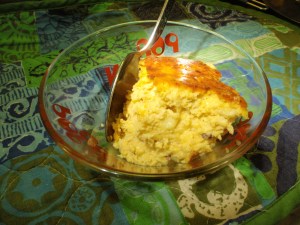My long lost relatives from Wisconsin came down for the weekend, bringing with them a welcome, if blustery, dip in temperature. We met at the SFC farmers market in Sunset Valley, affording me the opportunity to show off not only the kindergartner’s soccer game across the street, but Austin’s own Dai Due. Naturally they ordered the brats! The unexpected chill called for a steaming cup of gumbo, comforting and thick with local meats and shrimp. A hearty way to warm up for a Saturday of reconnecting, and enjoying and entertaining children. This week’s charcuterie offerings from Dai Due included salt pork and tasso (fashioned from local Richardson Farms pork), so I stocked up (both keep fine in the freezer), armed to enrich my flexitarian diet.
Tomorrow’s the last day of HEB’s sale on Texas-grown corn at 4 for $1, and the days of comfortably heating up the big oven are becoming a memory. So grab yourself a couple bucks of ears and pud(ding) ’em together with that salt pork. Add local cheese and eggs, backyard herbs and organic creams and you’ve got an easy side dish that you might even make a meal out of. We did!
CORN PUDDING serves plenty
- 6 cups local corn kernels, from about 8 medium ears of corn.
- 6 local eggs, lightly beaten
- 1 cup organic cream. I like Organic Valley. Click for a coupon.
- ½ cup organic sour cream. Farmers’ Creamery brand of luxurious slow-cultured cultured cream, crafted without thickeners or stabilizers, is available at Natural Grocers uptown.
- 6 ounces local cheddar (1½ cups shredded). I love Full Quiver Farms extra sharp version. Look for their booths at Barton Creek and Austin Farmers Markets.
- 7 slices Dai Due salt pork, rendered. I slice and fry the whole chunk ahead of time and refrigerate whatever we don’t eat or use right then. Remember to save that precious grease! Fry your eggs or saute your bean base in it and feast like royalty.
- 1 Tablespoon turbinado sugar. I buy this in bulk and bring in my own (large) container. The staff tares the weight.
- scant teaspoon salt. I use Real Salt. Whole Foods sells this in bulk for the best deal.
- ½ teaspoon smoked paprika. For the lowest prices, I buy the majority of my spices in bulk, usually at Central Market.
- ¼ teaspoon ground turmeric
- ¼ teaspoon garam masala. Click for a recipe.
- 3 Tablespoons chopped fresh backyard herbs. Basil, chives and thyme combine well.
Preheat your oven to 350°. Butter up a 2-quart casserole dish. Set it inside a roasting or cake pan (at least 9″ X 13″) to configure a bain-marie (water bath). Start heating up water, most coolly accomplished in your microwave. I use a 1-quart Pyrex glass measuring cup. A couple or three of those should give you enough very hot water to come halfway up the sides of your casserole.
Bring a large pot of salted water to a boil over high heat. Add the corn and return to a boil. Cook the kernels for 1 minute and drain well. Process about 3½ cups of the corn in your food processor to yield a rough puree. Combine the puree with the whole corn kernels and the remaining ingredients. Turn the mixture into the casserole dish.
Place your bain-marie setup on a middle rack in the oven and pour the heated water into the roasting pan. Bake for 45 minutes or so, until the pudding is set and browned. You can test it for doneness with a bamboo skewer to be sure.
Carefully remove the casserole from the water bath and place it on a cooling rack. Let cool and set for 10 minutes before serving.
Tastes great at room temperature too!









